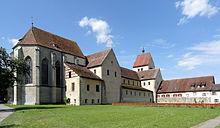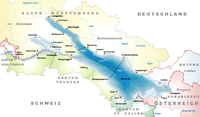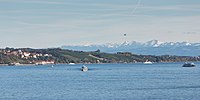Reichenau Abbey
Imperial Abbey of Reichenau Reichskloster Reichenau | |||||||||
|---|---|---|---|---|---|---|---|---|---|
| 724–1540 or 1548 | |||||||||
| Status | Imperial Abbeyof theHoly Roman Empire | ||||||||
| Capital | Reichenau Abbey | ||||||||
| Government | Theocracy | ||||||||
| Historical era | Middle Ages | ||||||||
• Founded | 724 | ||||||||
• GainedReichsfreiheit | Unknown724 | ||||||||
•Reichsfreiheitlost to Bishopric of Constance | 1540 or 1548 1540s | ||||||||
1757–1803 | |||||||||
| |||||||||
| Today part of | Germany | ||||||||
| UNESCO World Heritage Site | |
|---|---|
| Part of | Monastic Island of Reichenau |
| Criteria | Cultural: iii, iv, vi |
| Reference | 974 |
| Inscription | 2000 (24thSession) |

Reichenau Abbeywas aBenedictinemonastery onReichenau Island(known inLatinasAugia Dives). It was founded in 724 by the itinerantSaint Pirmin,[1]who is said to have fled Spain ahead of the Moorish invaders, with patronage that includedCharles Martel,and, more locally, Count Berthold of theAhalolfingerand theAlemannian DukeSantfrid I (Nebi).Pirmin's conflict with Santfrid resulted in his leaving Reichenau in 727.[2]
History
[edit]Reichenau quickly developed into an influential religious, cultural, and intellectual center.[3]Under AbbotHaitothe monastery began to flourish. It gained influence in theCarolingian dynasty,under AbbotWaldo of Reichenau(740–814), by educating theclerkswho staffed Imperial and ducal chanceries. AbbotReginbert of Reichenau(died 846) built up the important book collection.[4]AbbotWalahfrid Strabo(842–849), who was educated at Reichenau, was renowned as a poet and Latin scholar.[5]
Reichenau was greatly fostered by its position on the highway to Italy, which was frequented by Greek and Italian, and even Irish and Icelandic pilgrims and wayfarers. The Abbey stood along a main north–south highway between Germany andItaly,where the lake passage eased the arduous route. The Abbey of Reichenau housed a school, and ascriptoriumand artists' workshop, that has a claim to having been the largest and artistically most influential centre for producing lavishly illuminated manuscripts in Europe during the late 10th and early 11th centuries, often known as theReichenau School.An example of the scriptorium's production is thePericopes of Henry II,made for the Emperor, now inMunich.Walafrid Strabowas educated at Reichenau.[6]
Bishop Egino of Verona resided in Reichenau, and built (799) the parish church of St. Peter at Niederzell, a small Roman basilica with two towers, whither he retired to lead the life of a hermit, dying in 802. The patronage of the Carolingians resulted in the rapid growth of the monastery in importance, being granted successively immunity from secular authority, jurisdictio fori the status of a principality of the empire, and complete exemption from episcopal jurisdiction.[6]Reichenau has preserved its precious relics, which include the pitcher from thewedding at Cana.
The Abbey reached its apex under AbbotBerno of Reichenau(1008–48). During his time, important scholars, such asHermannus Contractus,lived and worked in Reichenau. In the second half of the 11th century, the cultural importance of the Abbey started to wane owing to the restrictive reforms ofPope Gregory VII,and also to rivalry with the nearbySt. Gall;in 1540, the Bishop of Constance, an old rival of the Reichenau abbots, became lord of Reichenau, and, under the control of the succeeding bishops, the abbey's significance dwindled.[6]
When the abbey lands were secularized (initially in 1757 and permanently in 1803) and the monks disbanded underNapoleon,part of Reichenau's famed library was preserved in the state library (Landesbibliothek) atKarlsruhe.TheGeographus Bavarusand several other important documents may be found in theBavarian State LibraryinMunich.Since 2001 a small community of Benedictines has been re-established at Niederzell (Sts. Peter and Paul).
Because of its historical importance and exceptional art and architecture, Reichenau Abbey (along with other monuments on the island) was inscribed on theUNESCOWorld Heritage Listin 2000.[7]
Burials at the abbey
[edit]See also
[edit]References
[edit]- ^Rosamond McKitterick,The Frankish Kingdoms under the Carolingians,(Pearson Education Limited, 1983), 42.
- ^Pierre Riche,The Carolingians: A Family Who Forged Europe,transl. Michael Idomir Allen, (University of Pennsylvania Press, 1993), 42.
- ^A. Zettler (5 September 1999).Report on the Nomination of the Monastic Island of Reichenau for Inscription on the World Heritage List of UNESCO(PDF)(Report). Historisches Institut, Universitat Dortmund.Retrieved20 August2022.
- ^M. Dorothy Neuhofer,In the Benedictine Tradition: The Origins and Early Development of Two College Libraries,(University Press of America, 1999), 34.
- ^Emily Albu,The Medieval Peutinger Map: Imperial Roman Revival in a German Empire,(Cambridge University Press, 2014), 49.
- ^abcSchmid, Ulrich. "Reichenau." The Catholic EncyclopediaVol. 12. New York: Robert Appleton Company, 1911. 1 January 2023
 This article incorporates text from this source, which is in thepublic domain.
This article incorporates text from this source, which is in thepublic domain.
- ^"Monastic Island of Reichenau".UNESCO World Heritage Centre.United Nations Educational, Scientific, and Cultural Organization.
- ^Paul Edward Dutton,The Politics of Dreaming in the Carolingian Empire,(University of Nebraska Press, 1994), 247.
External links
[edit] Herbermann, Charles, ed. (1913)."Reichenau".Catholic Encyclopedia.New York: Robert Appleton Company.
Herbermann, Charles, ed. (1913)."Reichenau".Catholic Encyclopedia.New York: Robert Appleton Company.
- Imperial abbeys
- 724 establishments
- 1803 disestablishments in the Holy Roman Empire
- Christian monasteries established in the 8th century
- Christian monasteries disestablished in the 19th century
- Religious organizations disestablished in 1803
- States and territories established in the 720s
- States and territories disestablished in the 1540s
- Monasteries in Baden-Württemberg
- Benedictine monasteries in Germany
- Merovingian architecture
- Landmarks in Germany
- Charles Martel





